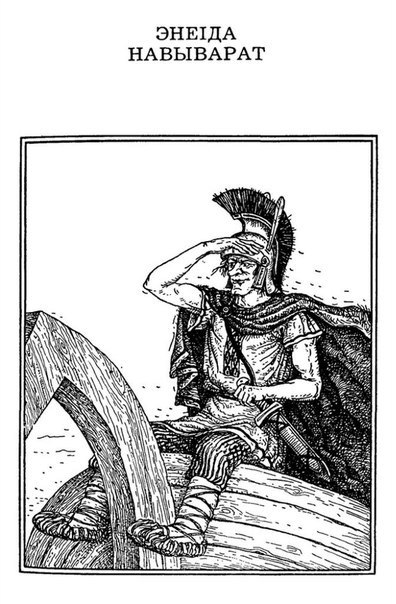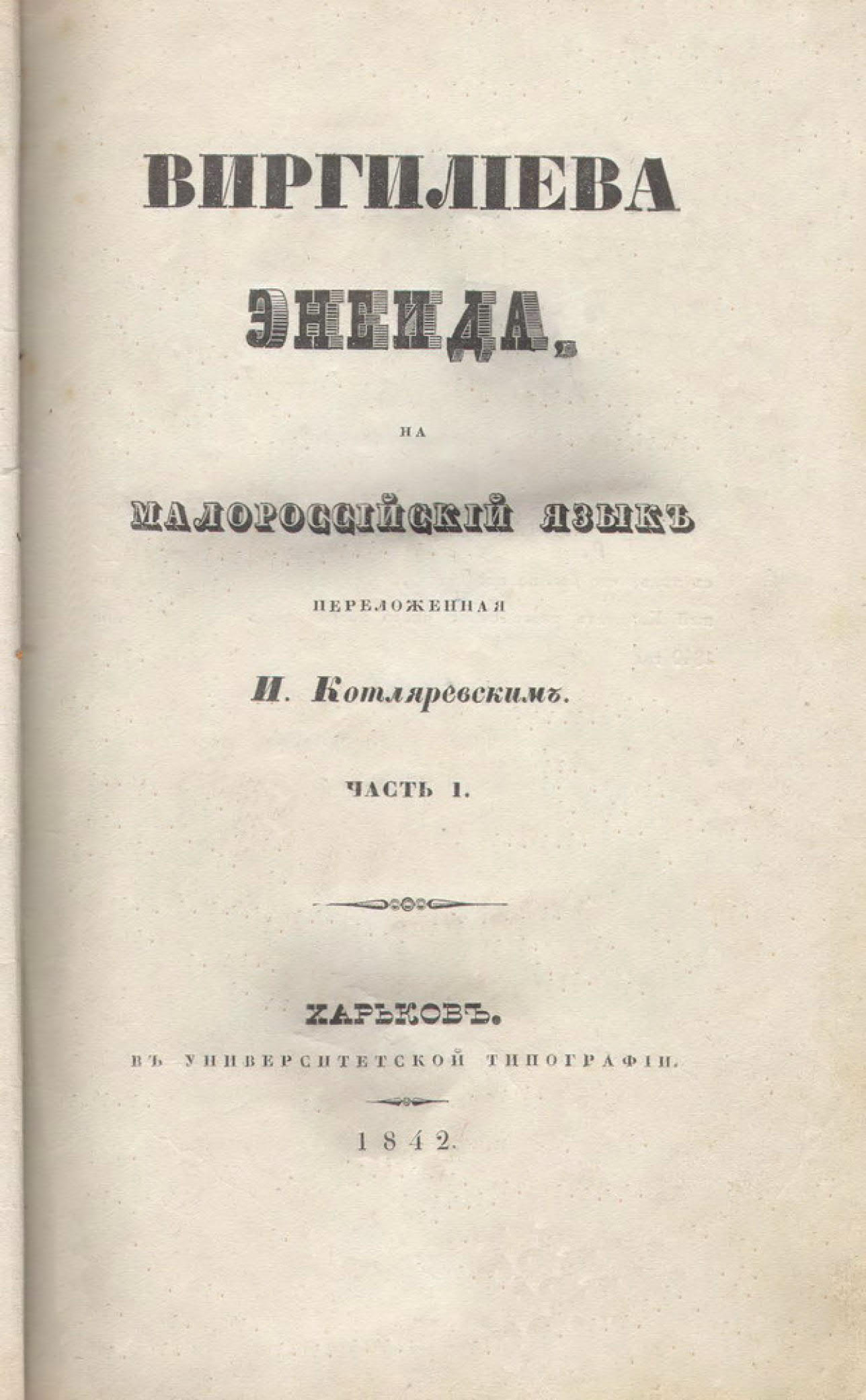Title of the work
Country of the First Edition
Country/countries of popularity
Original Language
First Edition Date
First Edition Details
"Энеида наизнанку" ["Aeneid Inside Out" ("Ėneida naiznanku")] / Маяк [Maiak] XXIII (1845), Saint Petersburg, p. 30–39.
More complete edition:
Karskiĭ, Evfim [Карский, Евфим], Белорусская Энеида наизнанку. С приложением текста сохранившихся отрывков [Belarusian Aeneid Inside Out. With the remained text fragments (Belorusskaia Ėneida naiznanku. S prilozheniem teksta sohranivshihsia otryvkov)], Kharkov [Харьков], s.n., 1908.
Available Onllne
knihi.com (accessed: June 10, 2018).
Genre
Mock-heroic poetry
Target Audience
Young adults (but “the low language” made it extremely popular among a wide range of poorly educated readers, now the poem is included in the required reading list for 9th grade (14–15 years old).)
Cover

Half-title page of "Aeneid Inside Out" [Энеіда навыварат (Eneida navyvarat)] edititon from 1982, Minsk: Iunatsva [Юнацтва]. Retrieved from fantlab.ru (accessed: April 6, 2022), © Illustrations Valery Slavuk [Валеры Славук], © 2005-2022 "Laboratoria Fantastiki" [«Лаборатория Фантастики»].
Author of the Entry:
Maria Pushkina, National Academic Janka Kupała Theatre, maryiapushkina@gmail.com
Peer-reviewer of the Entry:
Elżbieta Olechowska, University of Warsaw, elzbieta.olechowska@gmail.com
Daniel A. Nkemleke, University of Yaoundé 1, nkemlekedan@yahoo.com

Vikentsi Ravinski
, 1786 - 1855
(Author)
For a long time, Belarusian Aeneid was considered to be anonymous, but nowadays Vikentsi Ravinski (Вікенці Равінскі) is presumed to be the author of the text. He was born into a noble family in Smolensk region and received home education. During his military service, Ravinski used to live in St. Petersburg (where he got the opportunity to familiarize himself with literary and cultural novelties) and took part in the Napoleonic wars (1805–1807, 1812, in Germany and France). From 1826 he worked as a civil servant in the Orenburg province. After 1833 he returned to the Smolensk region. Ravinski wrote satirical and comic poems and a play, which were distributed as handwritten copies but remain still undiscovered.
Bio prepared by Maria Pushkina, National Academic Janka Kupała Theatre, maryiapushkina@gmail.com
Translation
Russian: Vikentiĭ Rovinskiĭ [Викентий Ровинский], Энеида наизнанку [Ėneida naiznanku], trans. K. Titov [К. Титов], Minsk: Дзяржаўнае вучэбна-педагагічнае выдавецтва БССР [Dziarzhaŭnae vuchebna-pedagagichnae vydavetstva BSSR], 1953.
Summary
After the fall of Troy, Aeneas, the son of Venus, along with his soldiers travel to Rome in order to establish a new kingdom there. Juno, who does not like Aeneas's mother, Venus, wants to thwart the hero. She talks Aeolus, the Keeper of the Winds, into raising a storm in the sea. But Aeneas appeals to Neptune for help. Neptune calms down the wind and soothes the sea. Venus helps her son too; she asks Zeus to support Aeneas. Zeus promises Venus that her son will happily arrive in Rome and will become the king of a great empire. Finally, at the end of a long journey the Trojans reach Carthage. Dido, the queen of Carthage, at first treats them warily, but becomes more hospitable after seeing Aeneas and invites everyone to a feast.
Analysis
Most likely the Belarusian version of The Aeneid was created under influence of the Russian (made by Nikolaĭ Osipov) and the Ukrainian (made by Ivan Kotliarevski) travesty variations on of Virgil's text. The plot of Vikentsi Ravinski’s Aeneid actually predetermined the characteristic issues of the national Belarusian literature of the ХІХ and early XX centuries. Virgil’s characters were divided into social classes (Aeneas himself "even though he was a nobleman, / he was not wicked", his companions were shown as skillful peasants and workers, and the gods were depicted as noblemen in the characteristic perception of ordinary people). The confrontation between the peasants and the nobility was the central theme in literature until the 1930s. It is extremely important that the chosen travesty-burlesque form produces recognition of populist moods and oral-literary tradition among the readership. The well-educated author showed that Virgil’s text was an important element of his worldview, while Russian and Ukrainian versions showed good examples of combining a classical text with folk culture.
Only a small part of Belarusian Aeneid survived to the present day. We do not know exactly how long the text was. The largest copy contains 303 lines, other parts of the poem have never been found. Colloquial speech, folklore motifs and oral tradition brought Belarusian Aeneid closer to a simple reader. In people’s consciousness, the text was thought to be folklore, despite unfamiliar names and mythological elements. Travesty has lowered the unknown gods to the level of old acquaintances of ordinary readers.
Rich ethnographic descriptions and vivid narration made Ravinski’s Aeneid a key text for the formation of Belarusian literature. Thus, Virgil and his characters happened to be involved in the creation of Belarusian national myth.
Further Reading
Blinava, Ėvelina [Блінава, Эвеліна], “Лінгвістычны аналіз паэмы 'Энеіда навыварат'” [Linguistic Study of the Poem “Aeneid Inside Out” ("Linhvistychny analiz paėmy 'Ėneida navyvarat'")], Роднае слова [Rodnae slova] 12 (2005): 31–34.
Kisialioŭ, Henadz’ [Кісялёў, Генадзь], Жылі-былі класікі: хто напісаў паэмы "Энеіда навыварат" і "Тарас на Парнасе" [Once upon a Time, Classics Lived Here: Who Wrote “Aeneid Inside Out” and "Taras on Parnassus" (Zhyli-byli klasiki: khto napisaŭ "Ėneida navyvarat" i "Taras na Parnase")], Minsk: Беларуская навука [Belaruskaia navuka], 2005.
Kisialioŭ, Henadz’ [Кісялёў, Генадзь], Пошукі імя [Looking for a Name (Poshuki imia)], Minsk: Мастацкая літаратура [Mastatskaia litaratura], 1978.
Khaustovich, Mikola [Хаўстовіч, Мікола], “Энеіда навыварат: спроба рэканструкцыі” [Aeneid Inside Out: An Attempt of Reconstruction ("Ėneida navyvarat: sproba rėkanstruktsyi")], Лекцыі па гісторыі беларускае літаратуры [Lectures on the history of the Belarusian literature (Lektsyi na historyi belaruskae litaratury)], available at khblit.narod.ru (accessed: June 28, 2018).
Paulouskaya, Hanna, “Virgil Travestied into Ukrainian and Belarusian”, Peter Mack and John North, eds., The Afterlife of Virgil, London: University of London, Institute of Classical Studies, 2018, 101–122.
Shaŭtsoŭ, Piatro [Шаўцоў, Пятро], Спрадвечнае: даследаванне аб часе і месцы напісання “ананімных” паэм “Энеіда навыварат” і “Тарас на Парнасе” [The Eternal: A Study of Time and Place of Writing of the “Anonymous” Poems “Aeneid Inside Out” and“Taras on Parnassus” (Spradvechnae: dasledavanne ab chase i mestsy napisannia "ananimnykh" paėm "Ėneida navyvarat" i "Taras na Parnase")], Minsk: Мастацкая літаратура [Mastatskaia litaratura], 1973.
Addenda

Ivan Kotlyarevsky, Aeneid, 1842 (1st full edition). The file is licensed under the Creative Commons.


